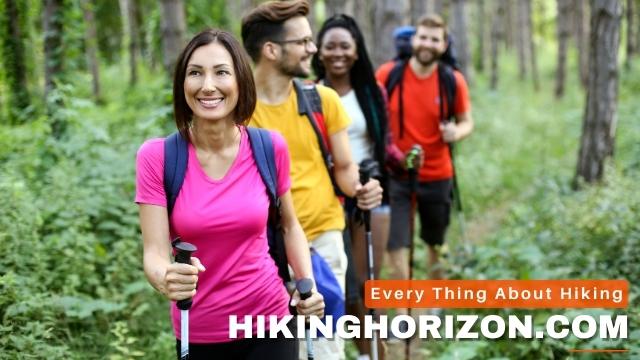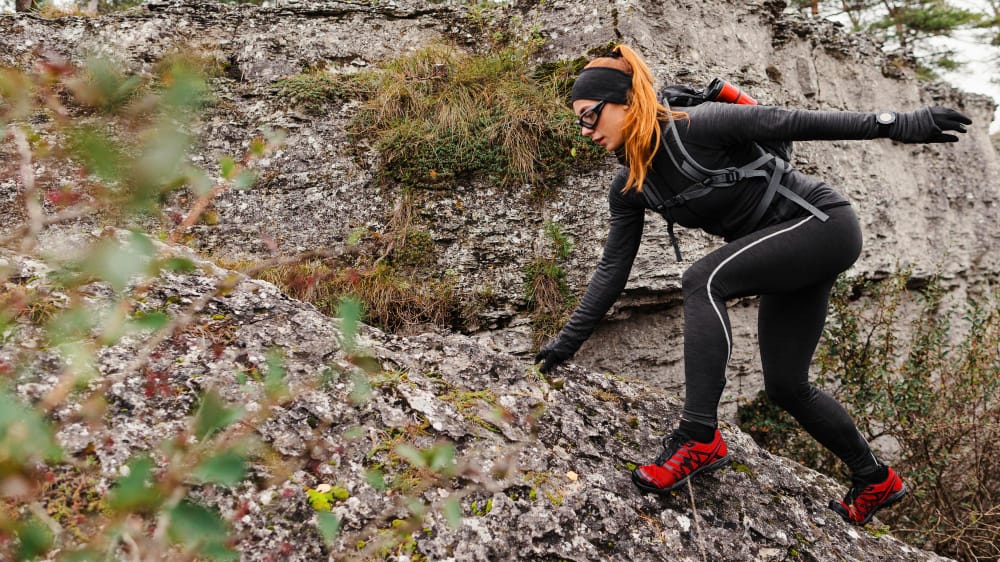
Yes, hiking can effectively get you in shape. Here is how:
- Burns substantial calories, up to 500 per hour
- Provides a full-body workout – engages lower body, core, and arms
- Builds muscle by toning and strengthening with aerobic activity
- Helps reduce overall body fat plus tones abdominal muscles
- Boosts mental health by lowering stress and anxiety
Hiking is adaptable to any fitness level. Consistency is vital for ongoing gains in cardiovascular and muscular fitness. With smart training, hiking offers excellent exercise for total body health.
Hiking stands out as one of the most favored outdoor activities. Good reason – it allows you to connect with nature, destress from everyday life, and get some exercise. But can you get in shape by hiking? The answer is yes – with the right approach, hiking can be an incredibly effective workout that burns calories, builds muscle, improves cardiovascular health, and more.
Those scenic trails are hiding crossfit-caliber training just waiting to be unlocked. This article will reveal how the simple act of walking uphill, when done strategically, can crush calories, build lean muscle, and take your cardiovascular fitness to new heights faster than you ever imagined.
We’ll uncover the hiking’s fitness potential, equip you with a smart training blueprint, and share insider techniques to maximize results. Expect to discover astonishing mental health benefits, facts about how many calories you can burn, and tips to target trouble zones like your core or problem areas.
Table of Contents
Can You Get In Shape by hiking? Benefits of Hiking for Fitness

Cardiovascular Endurance
Hiking involves constant movement and elevation, which keeps your heart rate up. It builds cardiovascular endurance over time, reducing your risk of heart disease. According to a study in the Journal of Strength & Conditioning Research, just one hour of hiking can burn up to 500 calories and elevate heart rate significantly. The more challenging the terrain, the greater the cardiovascular benefits.
Leg and Core Strength
The continuous movement involved in hiking engages all the major muscle groups in your legs and core. Going uphill activates your glutes, quads, hamstrings, and calves as you take thousands of steps. Maintaining balance and posture on uneven ground engages your core and challenges your stability. Over time, hiking can lead to noticeable muscle development in your legs and core.
Mental Health Boost
Being out in nature provides a mood boost and stress relief, reducing anxiety, depression, and fatigue. Hiking gives you time for self-reflection, escapism from daily pressures, and reconnection with your sense of awe. It can re-energize you mentally and physically.
Weight Loss
Due to the calories burned and full-body workout, hiking is an excellent form of exercise for losing weight and body fat. In one study, women who went hiking just once a week lost significant weight and body fat over 6 months compared to non-hikers. The key is hiking frequently and for long durations to maximize calorie burn.
So, in summary, hiking can target cardiovascular health, strength, mental health, and weight loss all at once through its holistic combination of aerobic activity, muscle engagement, and time in nature. That makes it a highly efficient and beneficial form of exercise.
How Often Hike to get in shape?

To actually get in shape from hiking, it’s important to hike regularly and make it a routine part of your exercise regimen. Here are some general guidelines on hiking frequency:
For Cardiovascular Benefits:
Aim to hike at least 1-3 times per week for a minimum of 30 minutes each session. It provides sufficient elevations in heart rate to boost cardiovascular health over time. But more frequent and longer hikes will provide greater benefits.
For Strength Gains:
To build significant leg and core strength, aim to hike 2-4 times per week for at least 45 minutes per session. Ensure your hikes involve challenging ascents/descents and uneven terrain to fully work the muscles. Strength training 1-2 days a week will complement hiking nicely.
For Weight Loss:
Aim to hike for 45-90 minutes at least 3-5 times per week at a strenuous pace for optimal fat-burning and weight-loss results. This level of frequency and challenge will put your body into a calorie deficit while building muscle, boosting metabolism, and burning fat.
For Mental Health:
Even just one short hike per week can provide mental health benefits! But aim for at least 30-60 minutes in nature 2-3 times per week for the greatest effects on mood, stress, and mental fatigue.
The more regularly you incorporate hiking as exercise, the more profound and well-rounded the fitness benefits will be. Plus, developing a consistent hiking habit is key for making it an enjoyable routine part of your active lifestyle.
| Fitness Goal | Recommended Hiking Frequency |
|---|---|
| Improve Cardiovascular Health | 1-3 times per week for 30-60 mins |
| Build Leg and Core Strength | 2-4 times per week for 45-60 mins |
| Lose Weight and Body Fat | 3-5 times per week for 45-90 mins |
| Boost Mental Health | 2-3 times per week for 30-60 mins |
| Train for a Hiking or Backpacking Trip | 3-5 times per week, building up distance/weight |
| General Fitness Maintenance | 1-2 times per week for 30-60 mins |
What Hiking Intensity gets you in shape?

To truly get in hiking shape, it’s important to hike at an intensity challenging enough to continually improve your fitness. Here are some tips:
Choose Hilly, Uneven Routes
Look for trails with plenty of ascents, descents, and rough terrain. It engages your muscles more while elevating your heart rate. Avoid flat, smooth routes.
Use Trekking Poles
Trekking poles involve your upper body, engage your core, and let you dig in and power yourself uphill with greater intensity. It can raise your heart rate while making descents easier on the knees.
Wear a Weighted Vest
Adding extra weight via a vest forces your muscles to work harder on the uphills while also burning more calories. Start with 5-10% of your body weight and build up slowly.
Monitor Your Heart Rate
Aim to average 60-75% of your max heart rate on hikes for optimal calorie burn and cardiovascular benefit. That’s about 110-150 bpm for most people. Use a fitness tracker or heart rate monitor.
Go Farther or Faster
Gradually increase hike distance and pace to continually challenge yourself. Mix longer endurance hikes with interval hiking (periods of faster hiking between slower recovery intervals) to boost intensity.
Shorten Rest Breaks
Taking fewer brief breaks pushes you both mentally and physically. Once comfortable, opt for hiking poles rather than stopping to rest frequently.
Using some of these techniques can turn even short hikes into highly effective, full-body workouts that provide greater fitness benefits over time. Listen to your body, take it slow, and gradually increase the intensity.
5 Tips To Get In Shape by Hiking

If you’re just getting started hiking for fitness, follow these tips:
- Research Your Trail Options
Doing some research on potential trials is key to starting strong. Look for details like length, elevation profile, layout, and difficulty rating. It helps select routes well-suited to your current fitness that you can progress on over time.
Favor loop trails over out-and-backs initially – it’s easier to modify distance mid-hike on loops versus being committed to traveling back the way you came. Also, pick trails close enough to home or work to access them frequently. Proximity and convenience remove barriers to regular training.
- Gear Up Appropriately
For day hiking fitness trips that help you get in shape, you just need a few key pieces rather than full backpacking gear. Sturdy trail running shoes provide good grip and stability on varied terrain, though regular athletic shoes work too.
Focus on comfort by wearing moisture-wicking layers to handle changing temperatures between sun and shade. A light jacket lets you adjust to elevation shifts and exertion levels.
While optional, fitness trackers like an Apple Watch help monitor stats like heart rate zones and progress over time. They provide helpful feedback for dialing in your training.
Never forget water – always pack ample hydration for any length of the hike. Dehydration can sneak up fast. You may also want snacks, a phone, first aid basics, and sun protection – better to have them and not need them!
- Start Small And Progress Slowly
When first getting started, pick easy local trails under 2 miles with moderate inclines to build confidence and fitness gradually. Avoid steep or grueling routes initially. The goal at the beginning is simply to complete the hike comfortably.
Take breaks as needed on benches or scenic overlooks to rehydrate, fuel up, and soak in the surroundings. There’s no need to rush. Hiking at a sustainable, enjoyable pace allows you to fully reap the mental health perks of being immersed in nature.
- Train Consistently
After nearly 20 years in strength and conditioning, the biggest fitness advice I can give is: Be Consistent! Choose a hiking schedule that fits your life, then stick to it as much as possible for at least 30 minutes 3-4 days per week.
If you occasionally miss planned hikes, substitute neighborhood walks or treadmill sessions to maintain the routine. Consistency creates habits, and habits drive results. The first few weeks of developing a new fitness habit require grit, but it gets easier.
Hiking offers a major advantage for consistency compared to gym workouts. While most dread things like the treadmill, hitting the trails is an uplifting escape into nature that people look forward to. Unwinding outdoors makes fitness feel rewarding rather than like a chore.
Making hiking a non-negotiable fixture in your weekly schedule through consciously creating habits is key. Fitness becomes an effortless bonus of following enjoyable routines rather than a forced separate pursuit. Achieving peak shape ultimately comes down to that consistency.
- Enjoy the Journey and the Destination
When hiking for fitness, don’t become so focused on calories burned and results that you lose sight of having fun. Embrace all the aspects that make hiking more rewarding than gym workouts.
Being immersed in nature, taking in beautiful scenery, and escaping stress are huge perks. Create rewarding experiences by hiking at sunrise, bringing friends along, taking photos, and simply being present.
There are so many ways to enhance each trip and ensure your soul is recharged too. Play with different times of day, locations, company, and ways to incorporate more joy, like bringing your pup. Keep your favorite trails feeling fresh.
By fully engaging your senses and maintaining wander along the path, your mind and body both benefit tremendously. Hiking for fitness should energize your spirit as much as your muscles.
Related Articles:
Ideal Hiking Duration For Fitness

Getting in shape requires hiking long enough to elevate your heart rate, engage muscles, and burn calories. Here are some general hiking duration guidelines for fitness:
For Cardio Endurance:
Aim for a minimum of 30 minutes of continuous hiking, but 60 minutes or longer is better for optimal cardiovascular benefit. This sustained activity significantly boosts heart health.
For Strength:
Hike for at least 45-60 minutes to properly fatigue the leg and core muscles to spur adaptation. Short hikes don’t require muscle endurance. Go for longer (60-120 minutes) for hiking-specific strength.
For Weight Loss:
Brisk hiking for 60-90 minutes burns hundreds more calories than shorter hikes, leading to greater fat loss over time. But any hiking is better than none when it comes to weight management.
For Mental Health:
Even just 30-45 minutes in nature while hiking can provide mental health perks. But longer hiking durations allow for greater stress relief, mind-clearing, and a sense of rejuvenation from the outdoors.
Of course, opt for longer hiking durations as your fitness improves. Hiking for several hours at a time provides the most well-rounded fitness benefits while also letting you enjoy the hiking experience. But start where you can and build up hiking endurance over time.
types of hiking and thier effect on body
| Type of Hiking | Terrain | Effect on Body |
|---|---|---|
| Day hiking | Varied trails, moderate distances | Legs, glutes – gradual pace |
| Fast-paced trail running | Trails with some hills | Heart, lungs, legs – moderate pace |
| Backpacking | Long distances over multiple days | Legs, back, core – gradual pace |
| Peak bagging | Summit hikes, high elevation | Heart, lungs, legs – moderate pace |
| Scrambling | Off-trail, rocky, steep | Core, balance – moderate pace |
| Snowshoeing | Snow-covered, variable terrain | Legs, glutes – moderate pace |
| Ultralight hiking | Long miles with minimal pack weight | Heart, legs – gradual pace |
| Power hiking | Steeper grades & pace for training | Heart, legs, glutes – rapid pace |
| Rugged trail hiking | Rocky technical terrain, river crossings | Core, balance, grip strength – moderate pace |
one of the best exercises ─ Weighted backpacking
Consider adding weight via a backpack or weighted vest to take your hiking workout to the next level. This simple trick forces your muscles, heart, and lungs to work harder with each step. Here’s how to do it effectively and safely:
Start Low
Only add 5-10% of your body weight when starting out. It could be as little as 5-8 pounds. Too much added weight early on can lead to injury.
Progress Gradually
Add just 1-2 pounds per hike or every few hikes. Give your body time to adapt to handling the extra weight during long durations of hiking.
Pack Thoughtfully
Place heavier items like water bladders high and centered in your pack to distribute weight effectively. Pack lighter gear on the bottom and periphery.
Focus on Good Form
Concentrate on maintaining a strong upright posture and engaging your core muscles to carry the weight properly. Let your legs drive each step.
Listen to Your Body
Reduce the load if you experience pain, strain, or discomfort from the added weight. It’s better to hike lighter with good form than overload your body.
Adding weight makes hiking significantly more challenging. But it transforms an ordinary hike into a hardcore strength and cardio workout that kicks your fitness up a notch. Just take it slowly and focus on proper form.
Strength Training to Complement Hiking
While hiking works your legs and core, adding strength training 1-2 days per week provides huge fitness benefits:
Full-Body Strength
Strength training works the upper body and smaller stabilizer muscles that hiking misses. It leads to better overall fitness.
Injury Prevention
Improved muscular strength and balance from resistance training help stabilize joints and prevent hiking injuries.
Increased Calorie Burn
More muscle mass from strength training means you’ll burn more calories hiking and at rest for faster weight loss.
Greater Stamina
Getting stronger makes hiking feel easier and allows you to go farther and faster.
Muscle Recovery
Lifting helps trigger muscle repair and adaptation in between hikes.
Aim for 20-30 minutes of strength training after an easy hike day or on rest days. Squats, lunges, and deadlifts build hiking-specific lower body/core strength. But be sure to train the upper body as well.
Weekly basic Hiking Schedule
To see maximal fitness results from hiking, aim for a schedule like this:
Monday: Rest Day or 30 Minutes Light Hiking
Tuesday: 60 Minute Brisk Hill Hike
Wednesday: 45 Minute Strength Training Session
Thursday: 2 Hour Long Hike on Variable Terrain
Friday: 30 Minute Recovery Hike
Saturday: 3-Hour Strenuous Hike with Added Weight
Sunday: Rest Day
It provides a combination of challenging cardiovascular hiking, strength training for full-body fitness, and enough recovery to allow your body to adapt. Feel free to shift the schedule based on your needs. Just be sure to hike frequently!
Healthy Eating for Hiking Fitness
Fueling properly goes hand-in-hand with exercise when getting in shape. Follow these nutrition tips to complement hiking:
Eat Energizing Carbs
Choose whole-grain carbs to provide sustained energy for hikes. Good options: oats, quinoa, sweet potatoes.
Load Up on Anti-Inflammatory Foods
Fruits, vegetables, fatty fish, and nuts provide antioxidants and nutrients that aid muscle recovery after tough hikes.
Hydrate Well
Drink plenty of water and electrolyte sources like coconut water to stay hydrated pre/during/post-hike.
Refuel After Hikes
Consume carbs plus protein within 60 minutes of finishing a hike to replenish glycogen stores and build/repair muscle.
Limit Added Sugar
Avoid sugar spikes and crashes from sweet soda. Time natural sugars from fruit wisely around hikes.
Reduce Processed Foods
Eat more whole, unprocessed foods to get lean while providing proper nutrients for performance and recovery.
Good nutrition enhances your fitness results from hiking by fueling your body properly. But don’t over-restrict calories, especially with increased activity from hiking.
Allowing rest and recovery after mountain hike
While frequent hiking is great for fitness, be sure to balance it with plenty of rest and recovery:
- Take at least 1 full weekly rest day with no strenuous activity to allow muscle repair.
- Avoid hiking the same muscle groups 2 days in a row. Space out leg-heavy hikes.
- Listen carefully to muscle soreness signals. Take extra rest if needed.
- Prioritize sleep by getting 7-9 hours nightly for tissue regeneration hormone regulation.
- Consider supplements like magnesium, omega-3s, and anti-inflammatories to support recovery.
- Stretch well, foam roll, and use other recovery techniques to speed muscle bounce-back.
- Periodically, take an easy week with reduced hike intensity/frequency to avoid overtraining.
Rest allows your body to get stronger and fitter. Without adequate recovery, fitness gains will stall. Be patient and let your body adapt properly.
Safety Tips for Hiking Fitness
While hiking can build your fitness, be sure to hike safely with these precautions:
- Wear sunscreen, insect repellent, and layered clothing to prevent sunburn, bites, and scrapes.
- Bring plenty of water, electrolyte sources, and snacks to stay fueled and hydrated.
- Hike with a partner or group when possible, and share your hike plan with someone.
- Know how to use a map, compass, or GPS to avoid getting lost.
- Research trail conditions and only hike within your fitness capability.
- Carry a first aid kit with you and make yourself familiar with basic first aid principles.
- Tell someone your expected return time and stick to it.
- Always carry emergency/communication devices like a whistle or satellite communicator.
- Beware of wildlife, insects, and plants. Give animals space. Learn what’s toxic.
- Stop hiking and seek help if you feel pain, dizziness, nausea, or other concerning symptoms.
While unlikely, falls, storms, dehydration, and other risks are possible. Take steps to hike smart and stay safe as your fitness progresses.
Is Hiking Enough Exercise?
For many active individuals, hiking alone can provide all the exercise they need to stay fit. The combination of cardio, strength, and calorie burn ticks all the major fitness boxes. But there are a few factors to consider:
Your Fitness Goals
Walking alone can be enough if you only want basic health and fat loss. However, specific goals like running a race or heavy strength building may require supplemental training.
Hiking Frequency/Intensity
If hiking long durations with lots of hills 4-5 days per week, that can suffice on its own for most people. Less frequent/intense hiking may need supplementation.
Activity Level Outside Hiking
If you have a desk job and a sedentary lifestyle outside hiking, adding cardio/strength training can help. An active job or lifestyle compensates well.
Individual Needs
Some may require more focused hip/core strengthening to stabilize joints for rugged hiking. Others may need additional cardio. Assess your needs.
For many hikers, especially frequent/avid ones, hiking provides all the exercise they need to stay fit. But judiciously supplementing based on your goals, activity level, and body’s needs can optimize outcomes further.
how to get in shape for hiking

If you’re new to hiking and want to get a hiking fit before hitting the trails, there are several exercises you can do at home or the gym to build the necessary muscle strength and endurance. Here are some of the best training methods to prepare your body for the rigors of the trail.
Build Cardiovascular Endurance
Improving your cardiovascular fitness is crucial for any distance hiking. Try methods like:
- Long, slow runs
- High-Intensity Interval Training sprints
- Stair climbing machines
- Elliptical workouts
- Treadmill power walking on an incline
Aim for a mix of sustaining heart rate training combined with interval bursts.
Leg Power Exercises
Lower body and leg strength is vital for propelling yourself uphill and controlling descents. Bodyweight moves like squats and lunges performed to fatigue build hiking-applicable power.
Body Weight Squat
Stand with feet hip-width apart. Send hips back and bend knees to lower into a squat. Engage your core and keep your chest lifted. Aim for 3 sets of 15 reps.
Forward Lunges
Step forward with one leg, bending both knees to 90 degrees. Push back up through the front heel to starting position. Repeat for prescribed reps, then switch legs.
Add Resistance Training
Use resistance bands or weights for exercises that mimic hiking motions:
Lateral Band Steps
Place resistance band around ankles. Step laterally first to one side, then the other. Move for 30 seconds, rest, and repeat.
High Knee Marches
Tie resistance band in a loop around hips. March in place, driving knees high, engaging core. Go for 45-60 seconds.
Create a Strong Core
A strong core helps maintain posture and balance on uneven terrain. Prioritize moves like planks, crunches, and rotational exercises. Yoga provides excellent complementary core conditioning.
A training plan that includes endurance, leg strength, resistance, and core work will make you feel trail-ready in no time! Start slowly and focus on perfect form.
Frequently Asked Questions about getting fit by hiking
How can I get in shape for hiking season?
The best ways to get your body in shape before hiking season are to build up your cardiovascular endurance with activities like jogging, cycling, or using the elliptical, and strengthen your leg, core, and back muscles with exercises like squats, lunges, planks, and deadlifts. Start training 2-3 months before hiking season begins. Gradually increase your physical activity routine over time to prepare your body. Pro tip: wear a weighted vest or backpack during training to get used to carrying weight on day hikes.
What are the best training exercises to get you in shape for hiking?
Some of the best training for hiking includes walking lunges, squats, stair climbing, and using a resistance band around your thighs while walking to strengthen your legs. Core exercises like planks, side planks, and glute bridges prepare your back and core. You’ll need to build full-body strength and stamina to avoid injury on the trail. Do exercises like these 2-4 times per week, along with regular cardio, to get your body hiking-ready.
How can I train for hiking if I’m a complete beginner?
If you’re new to exercise, start by taking short walks around your neighborhood 3-4 days per week while gradually increasing duration. Add small hand weights on walks to strengthen your arms for trekking poles. Work towards longer walks and then short hikes on easy trails 1-2 days a week. Increase hiking distance and intensity over time. Stretch after each hike to build flexibility. Listen to podcasts or audiobooks while training to make it more enjoyable!
What muscles should I focus on to get in hiking shape?
Hiking works your whole body, but especially your legs, glutes, core, and back. Prioritize exercises that strengthen those areas. Squats, lunges, deadlifts, and leg presses will build lower body power to propel you up hills. Planks, crunches, and back extensions strengthen your core to stabilize your back while hiking. Bicep curls and bent-over rows build arm strength for using trekking poles. Yoga also improves flexibility and balance.
How can I train my heart and lungs for hiking’s cardiovascular demands?
Getting your heart rate up through cardio exercise is key. Brisk walking uphill is excellent hiking-specific training. Jogging, cycling, rowing, and swimming also build cardiovascular fitness. Interval training that combines short bursts of intense effort with active rest helps prepare for hiking’s elevations. When training, wear a heart rate monitor and aim to sustain 60-75% of your max heart rate.
What’s the best way to get my legs in shape for long miles on trails?
Hiking trails involve thousands of steps up and down hills, so strong legs are crucial. Incorporating lower body workouts into your routine is crucial for a well-rounded fitness regimen. Squats, lunges, leg presses, calf raises, and weighted step-ups are fundamental for overall lower body strength and tone. Include lateral moves like side lunges, too. Go for higher rep sets (12-15 reps) to build muscular endurance. Allow for rest days between leg sessions. Massage and stretch your legs often.
How can I strengthen my back and improve my posture for hiking?
Carrying a pack can strain your back, so building back/core muscles is key. Planks, supermans, back extensions, and good mornings directly target those areas. Do pull-ups or lat pulldowns for your upper back. Always keep your back straight, chest up, and core braced during lifting. Stretch your chest regularly, too. Maintain good posture when standing and sitting.
What exercises should I do to avoid knee or ankle injuries out on the trail?
Targeting the muscles that support and stabilize your knees and ankles helps avoid injury. Squats, lunges, leg presses, calf raises, and balance exercises like single-leg deadlifts strengthen those areas. Avoid overtraining. Wear supportive hiking shoes and use trekking poles for added stability on the trail. Taping or bracing vulnerable joints can help, too.
Are there any equipment-free exercises that can get me hiking-ready?
Yes, you can get in great hiking shape without any equipment! Bodyweight squats, lunges, planks, push-ups, and calf raises work for your major muscle groups. Add step-ups onto a bench or stair, walking lunges, side lunges, and jumping exercises to increase intensity. Yoga builds strength, flexibility, and balance, too. Go for hike walks and do stair steppers or hill sprints.
I have bad knees. How can I train for hiking without worsening them?
Low or no-impact activities like cycling, swimming, rowing, and the elliptical machine are gentler on knees while still providing cardio conditioning. Limit high-impact exercises by avoiding running. Strengthen your quads, hamstrings, and glutes with wall sits, leg extensions, and bridges to support your knees. Lose any excess body weight. Wear a knee brace when hiking. Consider using trekking poles for support.
Putting It All Together
Hiking can absolutely help you get in shape and transform your body composition if done frequently and at the right intensity. Follow these best practices:
- Hike 3-5 days per week for 45-90 minutes, including hill climbs
- Wear a weighted vest, use trekking poles, and go faster/farther to increase intensity
- Limit rest breaks and choose rugged, uneven terrain for a bigger challenge
- Strengthen your muscles 1-2 days per week through resistance training
- Allow for rest days and proper recovery to maximize fitness gains
- Fuel your hikes and recovery with energizing whole foods and hydration
Getting in true hiking shape takes consistency over time. But the benefits of cardiovascular, strength, mental health, and weight loss make hiking incredibly worthwhile as a fitness routine. Enjoy the journey!

SARAH LEE
Sarah has been hiking for over five years and is passionate about promoting the mental and emotional benefits of spending time in nature. She has written several articles on the topic and strongly advocates hiking as a form of therapy. Sarah is also a certified yoga instructor, often incorporating yoga and mindfulness practices into her hiking trips. She is dedicated to providing accurate and up-to-date information on trail conditions, difficulty levels, and must-see sights.

SARAH LEE
Sarah has been hiking for over five years and is passionate about promoting the mental and emotional benefits of spending time in nature. She has written several articles on the topic and strongly advocates hiking as a form of therapy. Sarah is also a certified yoga instructor, often incorporating yoga and mindfulness practices into her hiking trips. She is dedicated to providing accurate and up-to-date information on trail conditions, difficulty levels, and must-see sights.




Pingback: Can Hiking Be a Job? Unleashing the Truth Behind the Dream - Hiking Horizon